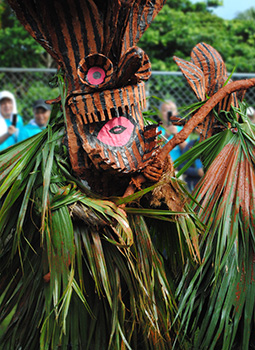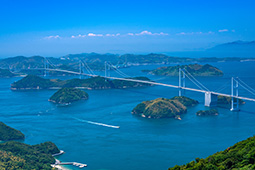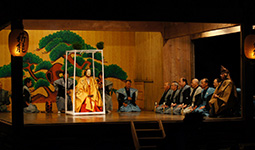INDEX
- English
- 日本語

Nagashima Shunsuke, emeritus professor at Kagoshima University - English
- 日本語

Snow-capped Mt. Miyanoura on Yakushima Island

The former Nokubi Church built in 1908 on Nozaki Island in the Goto Islands 
Performance of the Akusekijima no Boze masked ritual on the island of Akusekijima in Kagoshima Prefecture. 
Islands of the Seto Inland Sea as seen from Mt. Kiro Observatory in Ehime Prefecture 
Noh stage on Sado Island
November 2021
The Diverse Islands of Japan

Japan is exceptional even among island nations for its large number of islands. We spoke with Nagashima Shunsuke, emeritus professor at Kagoshima University, about the characteristics of Japan’s islands.

Professor Nagashima, you have visited many islands in Japan and abroad. What characterizes the islands of Japan?
Japan is at a distance from the continent, and the entire country is composed of islands. A major characteristic is that the islands are scattered very widely from east to west and north to south. When many Japanese hear the word “island,” they think of small islands other than Hokkaido, Honshu, Shikoku, Kyushu, and Okinawa Island, but there are many such small islands, and Japan is exceptional even among island nations for its large number of islands.*
In addition, many of the islands in Japan are characterized by their unique nature and culture, and are rich in diversity. Some islands are internationally acclaimed for their uniqueness and are inscribed as UNESCO World Heritage Sites. For example, Yakushima Island in Kagoshima Prefecture, a World Natural Heritage Site, has a steep topography that goes straight from coast to mountains about 2,000 meters high. The coast has a subtropical climate, but it snows in winter at the top of the mountain. It is a single island that possesses all the climate characteristics of the long country of Japan from north to south. The World Cultural Heritage Site “Hidden Christian Sites in the Nagasaki Region” in Nagasaki and Kumamoto Prefectures is a group of heritage sites that tells the story of the hidden Christian tradition of secret worship that coexisted with traditional Japanese religions and general society in the Edo period (1603–late 1860s) when the Christian faith was prohibited. The site consists of villages on islands such as the Goto Islands.

In addition to World Heritage Sites, “Raiho-shin: ritual visits of deities in masks and costumes,” which is also inscribed on the UNESCO Representative List of the Intangible Cultural Heritage of Humanity, includes ten annual events, four of which are performed on islands; namely, the “Koshikijima no Toshidon” in Satsumasendai City in Kagoshima Prefecture, “Satsuma-ioujima no Mendon” in Mishima Village in Kagoshima Prefecture, “Akusekijima no Boze” in Toshima Village in Kagoshima Prefecture, and “Miyakojima no Paantou” in Okinawa Prefecture. In all the events, islanders wearing outlandish masks and costumes go round the villages acting as visiting deities, admonishing people for being lazy and cleansing them of evil.

Which islands do you recommend for overseas visitors after COVID-19 subsides?
In Japan, there are many places where you can enjoy beautiful scenery made up of small islands floating in the sea, such as Matsushima in Miyagi Prefecture and Kujukushima in Nagasaki Prefecture, but among these, I especially recommend the islands of the Seto Inland Sea. An early example of a description of the beauty of the Seto Inland Sea and the islands situated there is the writings of Philipp Franz Balthasar von Siebold, who came to Japan to serve as a doctor at the Dutch trading post in 1823. As exchanges between Japan and the rest of the world became more active in the latter half of the nineteenth century, the Seto Island Sea became widely known overseas as well. When many Westerners visited Japan, they went there to see the scenery for themselves and praised the beauty of the sea and islands in travelogues and other texts. In 1934, these islands were designated as Japan’s first (one of three) national park to protect the environment and scenery there. In recent years, the islands of the Seto Inland Sea, such as Naoshima, have become internationally renowned as venues for contemporary art. Since 2010, the Setouchi Triennale has been held every three years with the participation of famous artists from Japan and abroad, with about 1.1 million people attending most recently in 2019.

Sado Island in Niigata Prefecture, where I live right now, is likewise an island rich in nature and culture that can be enjoyed by people from overseas. One highlight is Sado’s traditional performing arts. Indeed, various traditional performing arts have been passed down by residents for a long time. For example, there is noh, which is a form of musical and dance drama with a history of more than 600 years in Japan. There are about thirty noh stages on the island, constituting about one-third of all noh stages in Japan. There are also about 120 groups performing the ondeko, which involves people wearing oni (demon) masks dancing to the beat of taiko (Japanese traditional drums). On Sado Island, you can see these traditional performing arts at festivals and stages throughout the year. Especially well-known is the international art festival Earth Celebration, which has been held every summer since 1988. There, you can enjoy performances by artists from Japan and abroad, such as the world-class taiko group Kodo, which is based on Sado Island.

What kind of policies has Japan implemented for the development of remote islands?
Remote islands, which are surrounded by the sea on all sides, small, and distant from the big cities, used to trail far behind the rest of Japan in terms of infrastructure development. It was in response to this that the Remote Island Development Act was enacted in 1953 and contributed greatly to the development of remote islands. This act strengthened the financial support for remote islands and then improved infrastructure such as electricity, water and sewage services, ports, roads, and bridges, helping to stimulate industries such as fisheries and tourism.
Japan provides support not only to remote islands in Japan, but also to Pacific island countries, doing so in various fields such as infrastructure, energy, and the environment. One example is garbage disposal. In island countries with limited land, there are serious problems such as a shortage of garbage disposal sites and foul smells and waste water from disposal sites. In order to solve such problems, the Japan International Cooperation Agency (JICA) has introduced a garbage disposal method called the Semi-aerobic Landfill System (Fukuoka Method)** in some countries including the Independent State of Samoa, the Republic of Vanuatu, and the Republic of Palau, thus helping to reduce waste and foul smells. With the support of JICA, Hachioji City in Tokyo has assisted the Federated States of Micronesia in the Pacific with improving the garbage situation. In addition to providing garbage trucks, the city has dispatched staff to support the maintenance and inspection of garbage trucks as well as actively providing guidance on garbage collection. They have also engaged in initiatives such as public awareness-raising activities to reduce the use of plastic bags.
What are your thoughts on the future potential of Japanese islands?
Japan is now said to be a “100-year life society,” but as not only Japanese people but also people around the world will continue to live longer in the future, it becomes important to consider how to build “a society where we can live long healthy lives.” When it comes to addressing this issue, I think islands have great potential as places to promote health. For example, on islands such as Okinoerabujima Island and Amami-Oshima Island in Kagoshima Prefecture, and Kashikojima Island in Mie Prefecture, there are initiatives to restore health through so-called “thalassotherapy,” meaning marine therapy activities such as swimming in pools filled with seawater. Moreover, Tokunoshima Island in Kagoshima Prefecture is said to be an island of many childbirths and longevity where the birthrate is extremely high and there are many people aged 100 years old or older. It has been reported that this is potentially due to the island’s unique diet and culture. Islands have the potential to help people have long and healthy lives. Until now, remote islands have been inconvenient to reach from urban areas, and their isolation has been a disadvantage. But today, when remote work is encouraged, this is actually becoming an advantage. When city dwellers visit islands, they are taken far away from the everyday world and come into contact with rich nature and unique culture, which refreshes both mind and body. Once the COVID-19 situation has settled down, I hope many people from Japan and overseas will go to visit the various remote islands in Japan.
* According to the Japan Statistical Yearbook 2021 (Statistics Bureau of Japan), there are 6,852 islands including Hokkaido, Honshu, Shikoku, Kyushu, and Okinawa Island in Japan. According to a calculation by Emeritus Professor Nagashima Shunsuke based on the latest data of the Geospatial Information Authority of Japan, there are more than 14,000 islands with a circumference of 100 meters or more.
** The “Semi-aerobic Landfill System” (Fukuoka Method) is a waste disposal method jointly developed by Fukuoka City and Fukuoka University. Pipes are installed all around the disposal site to eliminate the waste water that oozes out of the garbage as well as take in outside air into the landfill to stimulate the activities of microorganisms in the garbage, thereby promoting its decomposition.

